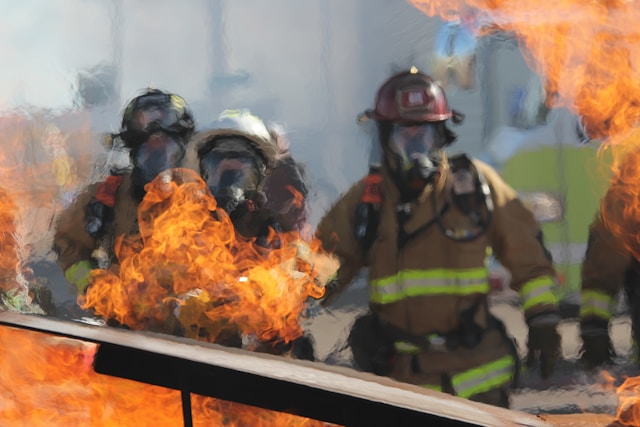Fire safety in buildings is a critical aspect of construction and maintenance, ensuring the safety of occupants and the preservation of property. This guide will delve into various components of fire safety, from the role of electromagnetic door closers to the importance of regular fire drills. Understanding these elements can help create safer environments in both residential and commercial buildings.
Importance of Fire Safety
Fire safety encompasses a range of measures designed to prevent the outbreak of fire, reduce its spread, and facilitate the safe evacuation of occupants. The consequences of inadequate fire safety measures can be catastrophic, leading to injury, loss of life, and significant property damage. Therefore, it is imperative for building owners, managers, and occupants to be well-versed in fire safety protocols.
Fire Alarms and Detection Systems
Types of Fire Alarms
- Smoke Alarms: These detect smoke particles in the air, providing early warning of a fire.
- Heat Alarms: Triggered by a rise in temperature, ideal for kitchens and garages where smoke alarms might cause false alarms.
- Carbon Monoxide Alarms: Detect dangerous levels of carbon monoxide, a deadly gas produced by combustion.
Importance of Fire Alarms
Fire alarms are crucial for early detection and warning, giving occupants the precious time needed to evacuate safely. Regular maintenance and testing of these systems are essential to ensure they function correctly when needed.
Placement and Maintenance
Proper placement of fire alarms is key to their effectiveness. Alarms should be installed in every bedroom, outside sleeping areas, and on every level of the home. For commercial buildings, alarms should be strategically placed to cover all areas, including basements and attics. Maintenance includes regular testing, replacing batteries annually, and ensuring the alarms are free from dust and debris.
Fire Extinguishers and Suppression Systems
Types of Fire Extinguishers
- Water Extinguishers: Suitable for Class A fires (ordinary combustibles like wood and paper).
- Foam Extinguishers: Effective on Class A and B fires (flammable liquids).
- CO2 Extinguishers: Ideal for electrical fires and Class B fires.
- Dry Powder Extinguishers: Versatile for Class A, B, and C fires (flammable gases).
Suppression Systems
- Sprinkler Systems: Automatically activate to release water when a fire is detected, effective in controlling or extinguishing fires before they spread.
- Gas Suppression Systems: Use inert gases or chemical agents to suppress fire without damaging sensitive equipment, which is ideal for data centers and laboratories.
Maintenance of Fire Extinguishers and Suppression Systems
Regular inspections and maintenance are vital to ensure that fire extinguishers and suppression systems are ready to function in an emergency. This includes checking pressure levels, inspecting for damage, and replacing expired components. Building managers should conduct annual inspections and ensure that staff is trained on the correct usage of fire extinguishers.
Training in Fire Extinguisher Use
It’s not enough to have fire extinguishers; occupants must know how to use them. Training sessions should be held regularly to educate people on the PASS technique (Pull, Aim, Squeeze, Sweep) and ensure they are comfortable with the equipment.
Emergency Lighting and Signage
Role of Emergency Lighting
Emergency lighting provides illumination during power outages, ensuring that escape routes remain visible. This is particularly important during a fire, where smoke and panic can obscure exits.
Importance of Clear Signage
Proper signage, including exit signs and directional indicators, guides occupants to the nearest exit. These signs must be clearly visible, even in low-light conditions, and should be regularly checked for functionality.
Regulations and Standards
Emergency lighting and signage must comply with local regulations and standards. These often specify the minimum brightness, duration of illumination, and placement of signs. Regular inspections should be conducted to ensure compliance and functionality.
Fire Drills and Evacuation Plans
Conducting Fire Drills
Regular fire drills are essential for preparing occupants for an actual fire emergency. Drills help familiarize everyone with evacuation routes and procedures, reducing panic and confusion during a real event.
Developing an Evacuation Plan
An effective evacuation plan should include:
- Clearly Marked Exits: All exits should be easily accessible and well-marked.
- Designated Assembly Points: Safe locations where occupants can gather after evacuating the building.
- Roles and Responsibilities: Assign specific tasks to individuals, such as floor wardens, to ensure an orderly evacuation.
- Communication Plan: Establish clear communication channels to keep everyone informed during an emergency.
Evaluating and Improving
After each drill, conduct a thorough evaluation to identify any issues or areas for improvement. This feedback loop ensures that evacuation plans remain effective and up-to-date with changing building layouts or occupant numbers.
Electromagnetic Door Closers
What Are Electromagnetic Door Closers?
Electromagnetic door closers are devices that automatically close doors during a fire, thereby containing the spread of smoke and flames. These devices are connected to the building’s fire alarm system and remain open under normal conditions, closing only when the alarm is triggered. Shop electromagnetic door closers with Door Controls Direct.
Benefits of Electromagnetic Door Closers
- Enhanced Safety: By ensuring doors close during a fire, these devices help compartmentalize the fire, preventing it from spreading and allowing for safer evacuation routes.
- Compliance with Regulations: Many building codes and fire safety regulations mandate the installation of electromagnetic door closers in certain types of buildings, especially in commercial and high-occupancy structures.
- Convenience: Under normal circumstances, doors with electromagnetic closers remain open, facilitating easy movement and accessibility for occupants, including those with disabilities.
Fire-Resistant Building Materials
Types of Fire-Resistant Materials
- Concrete: Provides excellent fire resistance due to its non-combustible nature.
- Gypsum: Often used in drywall, it contains water that helps retard fire spread.
- Intumescent Coatings: Expand when exposed to heat, forming an insulating layer that protects structural elements.
Implementing Fire-Resistant Materials
Incorporating fire-resistant materials during the construction phase is ideal, but they can also be retrofitted in existing buildings. Building owners should consult with fire safety experts to determine the best materials and solutions for their specific needs.
The Role of Fire Safety Training
Importance of Training
Fire safety training equips occupants with the knowledge and skills needed to respond effectively during a fire. This includes using fire extinguishers, understanding evacuation procedures, and performing first aid.
Components of a Fire Safety Training Program
- Fire Prevention: Educating occupants on how to prevent fires, such as proper storage of flammable materials and safe use of electrical equipment.
- Emergency Response: Training on how to react when a fire alarm sounds, including evacuation procedures and using fire safety equipment.
- First Aid: Basic first aid skills, including treating burns and performing CPR, can save lives in an emergency.
Regular Refresher Courses
Fire safety training should not be a one-time event. Regular refresher courses ensure that all occupants remain aware of fire safety protocols and are prepared to act quickly in an emergency.
Conclusion
Fire safety in buildings is a multifaceted discipline that requires attention to detail and a proactive approach. Ensuring fire safety involves continuous effort and vigilance. Regular updates to fire safety plans, ongoing training, and adherence to the latest regulations and technologies are essential to maintaining a secure environment. By prioritizing fire safety, we protect not only the physical structure of buildings but also the lives and livelihoods of those who inhabit them.











Leave a Review